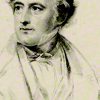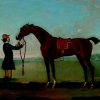With the passage of the Reform Bill the numbers of young, eligible and socially responsible MPs in the Commons had swelled to such an extent that there were many who were now in a position to give strength and patronage to any cause in which they might have a passing interest. John Walbanke Childers, a London financier, qualified on several counts for this and was an obvious candidate. He was probably known to both Robert Gouger and William Wolryche Whitmore because of his presence in the parliament and his support for the repeal of the Corn Laws. Both Whitmore and Childers had liberal views on land reform and the Corn Laws, prompting them both to publish tracts on the matter. Childers was also widely known to be a free trader. He had entered the parliament in the Whig tradition as the member for Cambridgeshire in 1832.
John Walbanke Childers’ electorate encompassed the Childers family seat of Cantley Hall, where he was the third-largest landholder in the county. The hall was a Georgian mansion set on more than 300 acres in the village of Cantley, not far from Doncaster. Childers owned more than 13,000 acres of property in Yorkshire, Cambridgeshire and Lincolnshire. The electoral franchise for Cambridgeshire had traditionally supported two candidates in the parliament, but at the time of the Reform Bill, a third member was added. Childers easily filled the vacancy and held the seat between 1832 and 1835. His political position was described as liberal. Unfortunately, he lost the seat at the general election of 1835, but in February 1836 won the seat of Malton in Yorkshire, which he held until April 1846. In 1847 he was again re-elected for Malton and held this seat until his retirement from parliament in 1852.
By June 1834 Gouger had corralled 32 significant people to become members of the provisional committee of the South Australian Association, and on 30 June, 2,500 interested persons attended a public meeting in Exeter Hall, which had been called to promote the scheme. Among others, Childers spoke in support of the project and supported the Bill in the Commons before it passed into law on 4 August 1834. Thereafter he continued to support the initiative, if not in a prominent active role, at least in spirit. His vote in the parliament ensured that his name would be remembered in the streets of North Adelaide forever.
On 18 September 1834 Childers was formally admitted to the membership of another related organisation, the South Australian Literary and Scientific Association, formed by some of the more enthusiastic young radical aspirants like Gouger, George Strickland Kingston, Thomas Gilbert, Richard Davies Hanson and John Brown. This is the group that organised regular weekly conversaziones, where intending colonists gathered to discuss the social, economic and administrative issues they were likely to face once they had emigrated. Whether or not Childers ever attended any of these lectures is not known, but given the formal way in which Gouger and the others went about things, he must have agreed to the use of his name.
The Walbanke–Childers dynasty were members of the British gentry for several generations. Leonard Childers acquired the Lordship of Branton in the early seventeenth century (in 1610). This peerage incorporated Cantley Hall. In the Domesday Book of 1086 Cantley is known as Canteleia. It continued in the Childers family until John Walbanke Childers’ granddaughter, Rowlanda Frances, sold it to the Grassmoor Co. Ltd in 1901.
Surprisingly, one of the most repeated references to Cantley in the literature concerns a famous racehorse called Flying Childers, bred by Colonel Leonard Childers in 1715. Before this horse rose to fame it had been used for such mundane tasks as carrying the letter bag between Cantley and Doncaster. In 1719 Colonel Childers sent the stallion to the nearby Newmarket Blood Stock Sales, from where the Duke of Devonshire purchased it and took it back to Chatsworth. Thereafter, it became a racehorse and was ultimately put to stud. The bay stallion assumed legendary status.
At the time John Walbanke Childers inherited the family title, he assumed ownership of huge estates in the County of York and elsewhere. Family members were by this time described as Grand Whigs.
John’s father, Colonel John Walbanke Childers, married the Hon Selina Eardley, the third daughter and co-heir of Samson, Lord Eardley at St George’s Parish in Hanover Square, London in March 1797. John, their first son, was the eldest of their eight children. He was born on 27 May 1798. Traditionally in such families, the first son inherited the estate, the second went into the church, the third joined a regiment and a fourth sometimes went to the colonies. This family attempted to follow such a pattern.
On the death of his father on 1 March 1812, John Walbanke Childers Esq of Cantley succeeded his father as the rightful heir to the huge family estates. Unlike the classical Grand Whig described above, John did go to Eton and on leaving school went to Oxford, where he took a Master of Arts degree from Christ Church College (in 1834). This was considered an excellent grounding for his political career which followed. As the master at Cantley, John also became involved in local affairs. He was a Justice of the Peace, a magistrate for the West Riding of York, Deputy Lieutenant of West Yorkshire and Cambridgeshire and patron of St Wilfrid’s in Cantley, where the family had held a ‘church living’ for generations.
In 1851 John acquired two further church livings when he purchased Ely Manor of Whittlesey, St Andrew, and Thorney Manor of Whittlesey St Mary, both from the Waldegrave family. This extended his patronage and entitlements to three parishes.
Tradition among landed families ensured that where there was an Anglican parish which lay within, or in the vicinity of, their estates, and because there was an obligation on the part of an aristocratic family to support the upkeep of such a church, the associated living was usually handed to a younger son within the family. This explains why John’s younger brother Charles took Holy Orders before being appointed to St Wilfrid’s. The church was regarded as High Anglican.
John Walbanke Childers’ first marriage was to Anne, the only daughter of Sir Francis Linley Wood, Bart of Hickleton Hall, in the nearby town of Doncaster. Childers had five children by Anne: three sons and two daughters. Unfortunately, all three sons died in premature circumstances.
Between July 1844 and January 1846, for reasons which are not entirely clear, John and Anne separated. Correspondence between her brothers, her father and John suggest that she behaved in a manner unbecoming for someone of her family standing and religious affiliation. Whether this is true or not has been rather difficult to establish and it is possible that the family’s religious disposition at that time has somehow clouded the issue.
Both John and Anne were Anglicans and are buried in the family vault. Anne’s two brothers were also raised as traditional Anglicans, but in the 1840s they both become involved in the Tractarian movement, otherwise known as the Oxford movement. This was a radical group of Anglicans seeking to renew the ‘Roman Catholic tradition’ embedded in the genesis of Anglicanism and to hold the line on ‘high church’ practices.
Given that John had parliamentary responsibilities in London and Anne was languishing at Cantley Hall, at least until it was rented out, some tension in their marriage was understandable. ‘Religious differences’ were cited as a reason for the couple’s separation. After a period of nearly two years apart John sought leave from parliament in April 1846 to become Steward of Her Majesty’s Chiltern Hundreds. This move relieved him of his onerous parliamentary duties and provided the respite needed for him and his wife to rebuild their marriage. The Hon William Thomas Spencer Wentworth Fitzwilliam, commonly called Viscount Milton, took the seat of Malton for the mandatory twelve-months duration. This was when John was re-elected again for Malton in 1847. Apparently the marriage was redeemed and he and Anne lived happily until she passed on in 1863.
The heir to John and Anne’s estate at Cantley Hall was Rowland Francis Childers, a Captain in the Scotch Fusilier Guards. He married Susan Anne Bouchier on 12 May 1853. Their first daughter, Florence, died as an infant, presumably while they were living in Florence. Rowland died while his wife was pregnant with their second child, Rowlanda Frances Walbanke Childers, who was clearly named by Susan to perpetuate the memory of her late husband. She survived to eventually take over her grandfather’s estate and Cantley Hall.
When John Walbanke Childers received news that Rowland was dying in Italy, he was devastated. Winter was fast approaching and on receipt of the bad news he was himself laid up in bed with chronic bronchitis. Unfortunately, his own health and the poor weather conditions in the English Channel delayed his departure to such an extent that by the time he arrived in Florence, his son had passed away. The whole tragedy affected John Childers deeply and some say he lapsed into a deep depression at the loss of his last son and heir. The huge retinue of staff at Cantley and the tenant farmers on his several estates grieved with him.
Slowly the Whig grandee began to recover and time eventually began to heal his deep psychological wounds. Three years after Anne died in 1863, John remarried. His new bride was his cousin, Selena Edwards, the daughter of Edward Radford and his aunt Eliza Diana Walbanke Childers. Selena was 23 years his junior and they presumably had twenty happy years together before John died in 1886. Selena died in 1916.
Turning to his parliamentary life between 1832 and the end of the 1840s, John Walbanke Childers’ city address was No. 6 Whitehall Place, London. This building was used as offices from the outset. Later, Childers was known to have taken up residence at 16 Eaton Square in London. He leased the Cantley estate in his absence to suitable tenants. The demands of the parliament were such that it was inconvenient to be travelling back and forth too frequently, and by staying in town he could join with other like-minded liberals in lively and constructive debate.
Childers joined the Reform Club in Pall Mall, as did many others who are named in Adelaide’s streets and squares. He was also a member of the Grillion’s Club, a small, non-political dining club for gentry, who used to meet together for polite exchange over lunch. This group comprised mainly barons and earls and formed in 1837 or thereabouts.
Childers was also a member of the Camden Society, the forerunner to the Royal Historical Society. It was established in 1838 as a forum for the collection and publication of rare manuscripts and historical material of significance. This was almost at the time that Childers published his ideas on the Corn Laws, an issue uppermost in the minds of many liberals in the Commons at the time. His small book Remarks on the Corn Laws was published in London in 1840.
All classes except the landed gentry were to benefit from the Corn Laws’ abolition, but even so, Childers said he was bound to support its removal, regardless. This shows him to be a reasoned and well-balanced thinker; one not given to impulse, who was prepared to calmly judge both sides of a controversial issue. All points of view hitherto canvassed on the Corn Laws in Britain he thought prone to exaggeration, and he reminds readers that dissension always accompanies any kind of dramatic change, legislated or otherwise. Eventually collateral turbulence dies down, he believed, and on this issue he didn’t foresee any great changes in the fortunes of either the population at large or the landholders.
Childers had a benevolent, if sometimes paternalistic attitude to what he described as the weavers among the manufacturers and the pauperised peasants of the Southern Counties. These classes suffered greatly because of the Corn Laws. He wanted the legislation repealed to defuse the unnecessary antipathy between the manufacturing and agricultural classes. It was, he claimed, destructive.
John Walbanke Childers passed away in February 1886 at the ripe old age of 88. His remains now reside in the family vault at St Wilfrid’s, in Cantley.






Comments